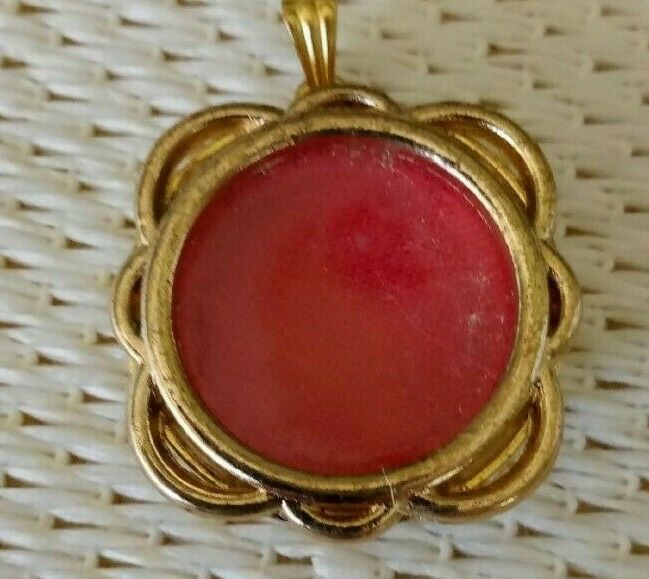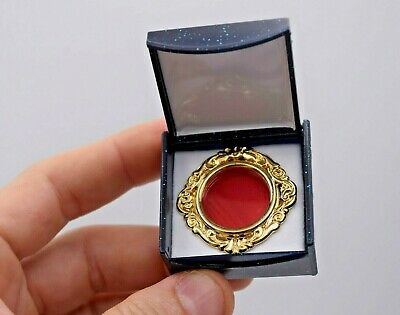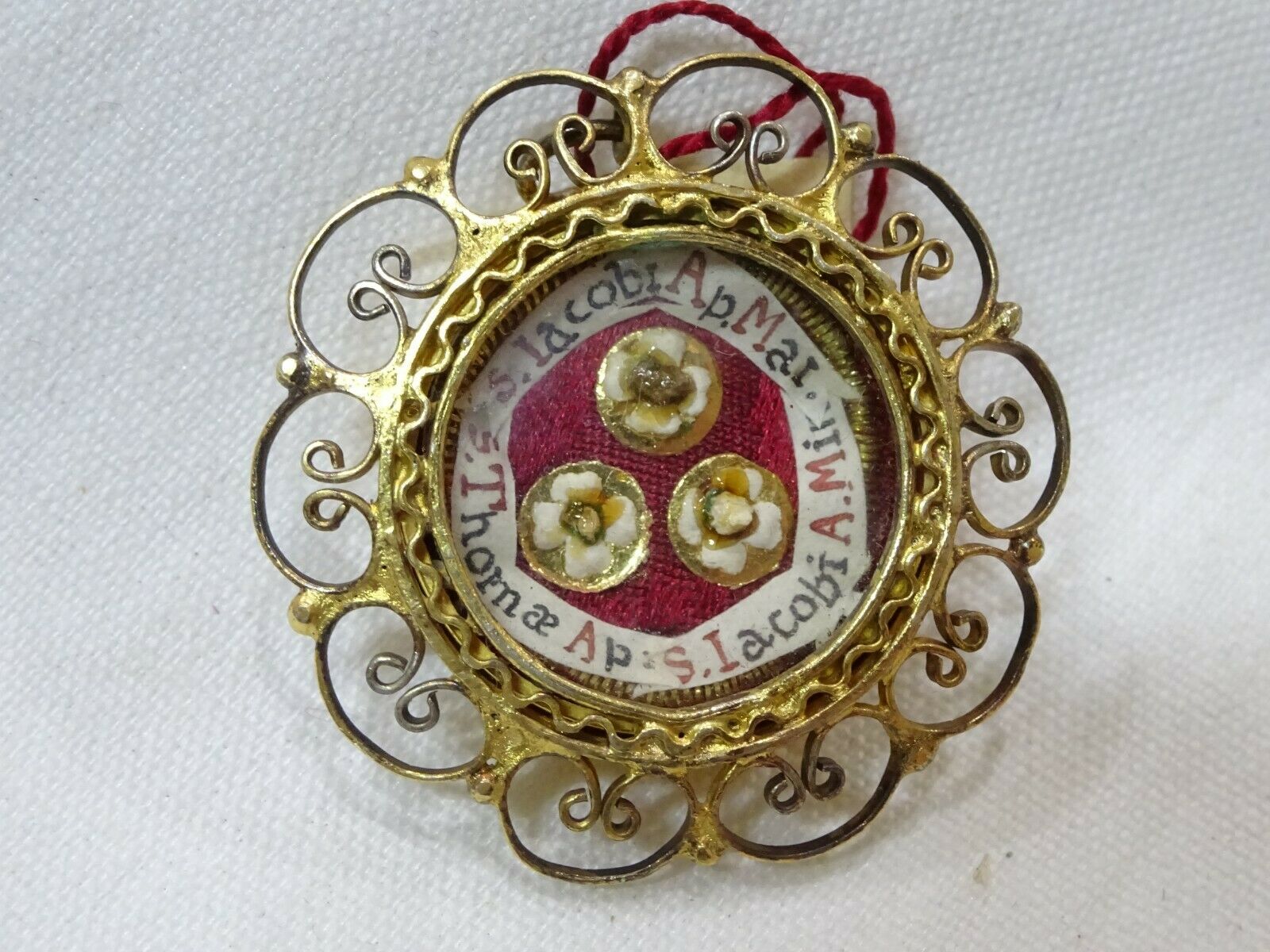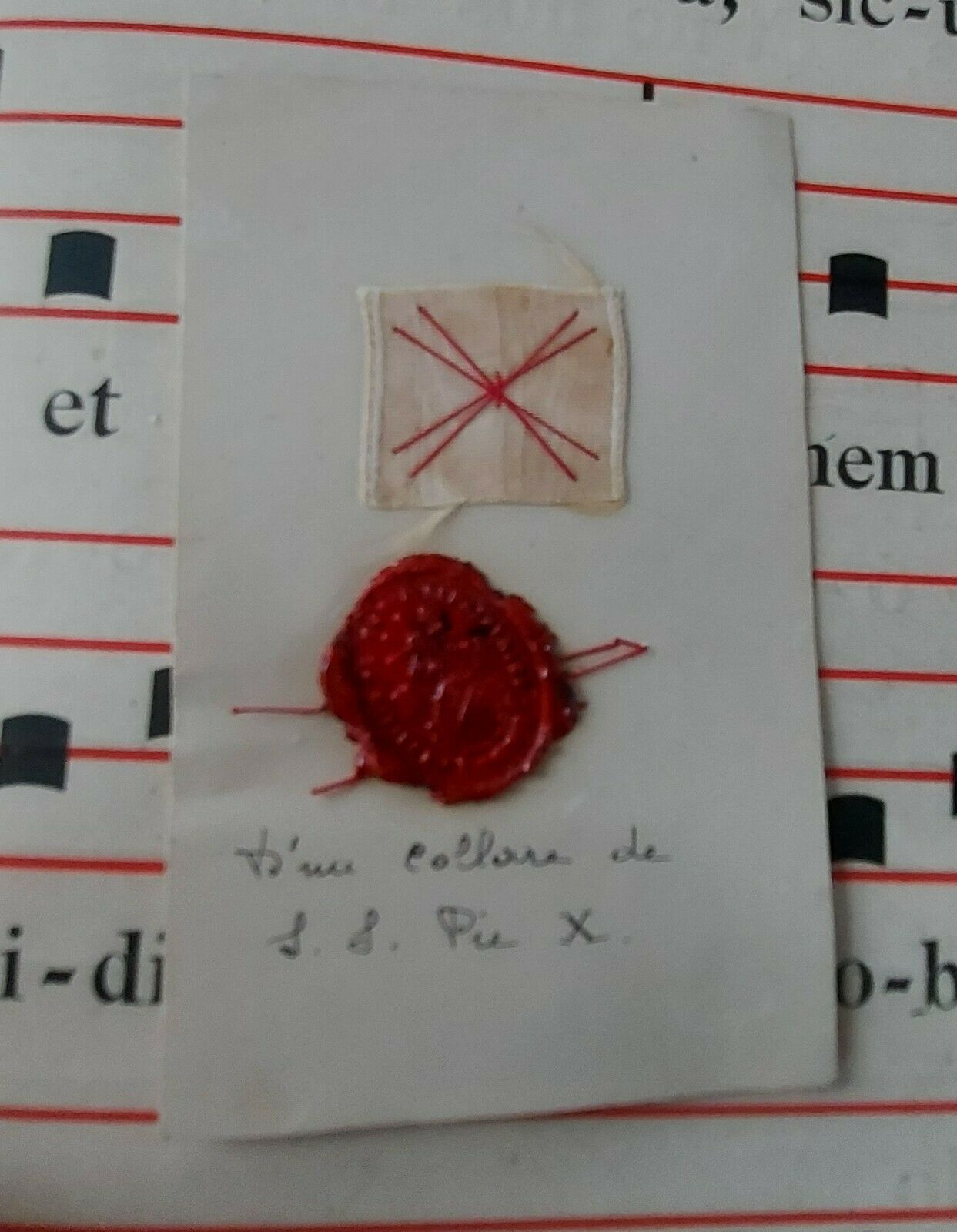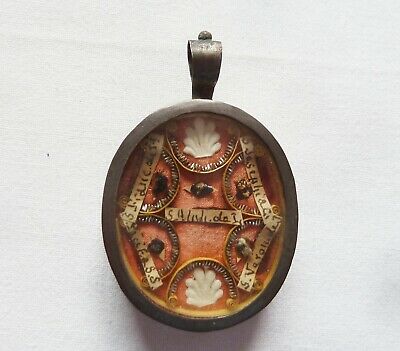-40%
Rare silver antique shrine 12x relic Hair Virgin Mary,Column Flagellation Jesus
$ 1188
- Description
- Size Guide
Description
This is rare small antique silver shrine.Inside important relics of theBlessed Virgin Mary (a hair), Saint Joseph (of his walking stick),the Column of Flagellation of Jesus, Saint Barbara, Saint Philip Neri, Saint Petronius of Bologna, Saint John the Baptist, Saint John the Apostle, Saint Januarius of Naples, Saint Cajetan, Saint Charles Borromeo and Saint Catherine del Ricci (of her clothing). All relics in place and wax seal and threads intact.
Measures 3,6 inch wide and 2,3 inch deep and 3,5 inch high.
Shipping and handling US$ 39,00
by registered priority mail, and tracking number. With multiple items, I will combine shipping. All my items are securely packet, to avoid all possible damage. I prefure payment by Paypal .
Please contact me if you have any questions
.
Items cannot be returned! I will combine shipping.
Please see my other auctions for more antique catholic items
This are antique items and no copie or new made fakes!
As per Ebay policy,this reliquary does not contain human remains but only objects of devotion. The auction is for the shrine, the relics are a gift.
Please be carefull when buying relics online. Fake relics are increasingly more and more of a problem. Most of the relics I sell are from convents in Belgium and Italy. I have been collecting relics for more than 25 years. I consider myself an expert.
Please contact me if you have any questions.
O
ur Non Paying Buyer process is now automatically managed by Ebay.
The process starts four days after auction end and closes as soon as payment is received. automatically after the eighth day.
The Column of Flagellation:
Upon entering the San Zeno Chapel, located in the Basilica di Santa Prassede, a dark marble object, spotted with white, lies in a niche to the right .The object appears to be an oddly large chess piece, but is allegedly the column upon which Jesus Christ was flogged in his final years.
During the medieval crusades, it was very common to take spoils from Jerusalem and bring them back to Rome. Some were then placed in churches as relics—such as the column itself, the crown of thorns (now in Notre Dame in Paris), or the bones of St. Jerome (now in the Basilica di Santa Maria Maggiore). The relic was taken from the Holy Land and brought to Rome in 1222 by Cardinal Giovanni Colonna the Younger—a member of the powerful Colonna family during the 13th century. Given to him by the King of Jerusalem after the Fourth Crusade, Colonna brought the column back to Santa Prassede, his cardinalate church since 1212 (the church that is given to a cardinal). The history of the column before 1222, however, is unclear.
At the top of the column was a metal loop, where Christ was bound to during his flagellation. Before its move to the Chapel of San Zeno in 1699, the column was not completely visible by the pilgrims, and would only appear on feast days. Currently, the column is housed in a reliquary made of bronze, designed by Duilio Cambellotti in 1898. The column is also incorporated in other Roman monuments, such as the relief sculpture in the Chigi Chapel, located in Chiesa di Santa Maria della Pace, and one of the angels located on Ponte Sant’Angelo
Blessed Virgin Mary:
The Feasts of 8 September originated in Jerusalem.
In the 7th century, in the Byzantine Rite and at Rome, the Birth of the Blessed Virgin was celebrated this day. The feast is also celebrated on September 8 in the Syriac Rite and on September 7 in the Coptic Rite.
The Feast of Our Lady of Sorrows was originally granted to the Order of the Servants of Mary in 1667; it was introduced into the Roman Calendar in 1814 and assigned to the third Sunday in September. In 1913 the date of the feast was assigned to September 15.
P
rofile
Mother of Jesus. Spouse of the Holy Spirit. Betrothed of Saint Joseph
B
orn
unknown, perhaps 20BC
celebrated on 8 September
Died
unknown
assumed into heaven, date unknown but celebrated on 15 August
N
ame Meaning
myrhh
Canonized
Pre-Congregation
Patronage
against epidemics
against flooding
against lightning
against storms
enlightenment
Africa (declared by Cardinal Lavigerie in 1876)
air crews
aircraft pilots
aviators
flyers
pilots, aircraft
Albania
Algeria
Andorra
Angola (21 November 1984)
Arabia
Austria
bicycle riders
bicyclists
cyclists
blood donors
builders
construction workers
Camillians
Order of the Servants of the Sick
Central Africa (proclaimed on 30 April 1915 by Pope Benedict XV, )
Central America
childbirth
Chile
China
Cistercian Order
clothworkers
coffee house keepers
coffee house owners
Saint Joseph
Also known as
Joseph of Nazareth
Joseph the Artisan
Joseph the Betrothed
Joseph the Worker
Memorial
19 March
1 May (Joseph the Worker)
3rd Wednesday after Easter (patronage of Saint Joseph of the Universal Church)
3 January on some local calendars
29 October (Armenian)
20 July (Coptic)
P
rofile
Descendant of the house of David. Layman. Builder by trade; traditionally a carpenter, but may have been a stone worker. Earthly spouse of the Blessed Virgin Mary. Foster and adoptive father of Jesus Christ. Visionary who was visited by angels. Noted for his willingness to immediately get up and do what God told him to do.
Died
1st century, prior to the Passion, of natural causes
N
ame Meaning
whom the Lord adds (Joseph)
Patronage
against doubt
against hesitation
accountants
attornies
barristers
bursars
cabinetmakers
carpenters
cemetery workers
children
civil engineers
confectioners
craftsmen
dying people
educators
emigrants
exiles
expectant mothers
families
fathers
furniture makers
grave diggers
happy death
holy death
house hunters
Saint Philip Neri
Also known as
Amabile Santo
Apostle of Rome
Philip Romolo Neri
Memorial
26 May
P
rofile
Though he was related to Italian nobility, Philip came from a poor family. His father, Francisco Neri, worked as a notary. Philip’s brother died in childhood, but his two sisters, Caterina and Elisabetta survived. Known as a pius youth, Philip was taught humanities by the Dominicans.
The family moved to San Germano in 1533 to help some relatives with their business, and while there Philip would escape to a local Dominican chapel in the mountains. Having received a vision that he had an apostolate in Rome, Philip cut himself off from his family, and went there.
He was befriended by Galeotto Caccia who took Philip in and paid him to tutor his two sons. Wrote poetry in Latin and Italian. He studied philosophy and theology, and when he tired of learning, he sold all his books and gave the money to the poor.
Philip began to visit and care for the sick, and impoverished pilgrims, and founded a society of like-minded folk to do the same. He became a friend of Saint Ignatius of Loyola. A layman, he lived in the city as a hermit. During Easter season of 1544, while praying in the catacomb of San Sebastiano, he received a vision of a globe of fire that entered his chest, and he experienced an ecstasy that physically enlarged his heart.
With Persiano Rose, he founded the
Confraternity of the Most Holy Trinity
. He began to preach, with many converts. In 1550 he considered retiring to the life of a solitary hermit, but received further visions that told him his mission was in Rome. Later he considered missionary work in India, but further visions convinced him to stay in Rome.
He entered the priesthood in 1551. Father Philip heard confessions by the hour, could tell penitents their sins before they confessed, and had the gift of conferring visions. He began working with youth, finding safe places for them to play, becoming involved in their lives.
Pope Gregory XIV tried to make him a cardinal, but Philip declined. His popularity was such that he was accused of forming his own sect, but was cleared of this baseless charge. In 1575 he founded the
Congregation of the Oratory
(
Oratorians
, a group of priests dedicated to preaching and teaching, but which suffered from accusations of heresy because of the involvement of laymen as preachers. In later years he was beset by several illnesses, each of which was in turn cured through prayer.
B
orn
22 July 1515 at Florence, Italy
Died
27 May 1595 at the church of San Maria in Vallicella, Italy of natural causes
Beatified
11 May 1615 by Pope Paul V
Canonized
12 March 1622 by Pope Gregory XV
Patronage
Gravina, Italy
Manfredonia-Vieste-San Giovanni Rotondo, Italy, archdiocese of
Rome, Italy
United States Army Special Forces
Venice, Italy
Saint Petronius of Bologna
Also known as
Petronius Vescovo
Petronius the Bishops
Petronio….
Memorial
4 October
P
rofile
Son of a Praetorian Prefect in Gaul, and may have been a Roman official himself. Pilgrim to the Holy Lands and the ascetics in Palestine in his youth. Bishop of Bologna, Italy. Built the monastery of Saint Stephen in Bologna; it was modeled on the holy places of Jerusalem. A fictional version of his life was popular in the Middle Ages.
Died
c.445 of natural causes
Canonized
Pre-Congregation
Patronage
Bologna, Italy, archdiocese of
Bologna, Italy, city of
Saint John the Baptist
Also known as
Iohannes Baptista
Joannes Baptista
John the Baptizer
John the Forerunner
John, son of Zachary
Juan Bautista
Yochanan ben Zecharyah
Memorial
24 June (birth)
29 August (death)
24 February (discovery of his relics)
P
rofile
Cousin of Jesus Christ. Son of Zachary, a priest of the order of Abia whose job in the temple was to burn incense; and of Elizabeth, a descendent of Aaron. As Zachary was ministering in the Temple, an angel brought him news that Elizabeth would bear a child filled with the Holy Spirit from the moment of his birth. Zachary doubted and was struck dumb until John’s birth.
Prophet. John began his ministry around age 27, wearing a leather belt and a tunic of camel hair, living off locusts and wild honey, and preaching a message of repentance to the people of Jerusalem. He converted many, and prepared the way for the coming of Jesus. He Baptized Christ, after which he stepped away and told his disciples to follow Jesus.
Imprisoned by King Herod. He died a victim of the vengeance of a jealous woman; he was beheaded, and his head brought to her on a platter. Saint Jerome says Herodias kept the head for a long time after, occasionally stabbing the tongue with his dagger because of what John had said in life.
Died
beheaded c.30 at Machaerus
buried at Sebaste, Samaria
relics in Saint Sylvester’s church, Rome, Italy, and at Amiens, France
Canonized
Pre-Congregation
Patronage
against convulsions
against epilepsy
against hail
against hailstorms
against spasms
baptism
bird dealers
converts
convulsive children
cutters
epileptics
farriers
French Canadians
innkeepers
lambs
monastic life
motorways
printers
tailors
Saint John the Apostle
Also known as
Apostle of Charity
Beloved Apostle
Beloved Disciple
Giovanni Evangelista
John the Beloved
John the Divine
John the Evangelist
John the Theologian
Memorial
27 December (Roman Catholic)
8 May (Greek Orthodox)
6 May (before the Latin gate)
P
rofile
Son of Zebedee and Salome. Fisherman. Brother of Saint James the Greater, and called one of the
Sons of Thunder
. Disciple of Saint John the Baptist. Friend of Saint Peter the Apostle. Called by Jesus during the first year of His ministry, and traveled everywhere with Him, becoming so close as to be known as
the beloved disciple
. Took part in the Last Supper. The only one of the Twelve not to forsake the Saviour in the hour of His Passion, standing at the foot of the cross. Made guardian of Our Lady by Jesus, and he took her into his home. Upon hearing of the Resurrection, he was the first to reach the tomb; when he met the risen Lord at the lake of Tiberias, he was the first to recognize Him.
During the era of the new Church, he worked in Jerusalem and at Ephesus. During Jesus’ ministry, he tried to block a Samaritan from their group, but Jesus explained the open nature of the new Way, and he worked on that principle to found churches in Asia Minor and baptizing converts in Samaria. Imprisoned with Peter for preaching after Pentecost. Wrote the fourth Gospel, three Epistles, and possibly the Book of Revelation. Survived all his fellow apostles.
Traditional stories:
Emperor Dometian had him brought to Rome, beaten, poisoned, and thrown into a cauldron of boiling oil, but he stepped out unharmed and was banished to Patmos instead. This is commemorated by the feast of Saint John before the Latin Gate.
When John was en route to preach in Asia, his ship was wrecked in a storm; all but John were cast ashore. John was assumed dead, but two weeks later the waves cast him ashore alive at the feet of his disciple Prochoros.
When John denounced idol worship as demonic, followers of Artemis stoned him; the rocks turned and hit the throwers.
He prayed in a temple of Artemis; fire from heaven killed 200 men who worshipped the idol. When the remaining group begged for mercy, he raised the 200 from the dead; they all converted and were baptized.
Drove out a demon who had lived in a pagan temple for 249 years.
Aboard ship, he purified vessels of sea water for drinking.
Ceonops, a magician, pretended to bring three dead people come to life; the “people” were actually demons who mimicked people so the magician could turn people away from Christ. Through prayer, John caused the magician to drown and the demons to vanish.
Once a year his grave gave off a fragrant dust that cured the sick.
Died
c.101 at Ephesus (in modern Turkey)
a church was built over his tomb, which was later converted to a mosque
Canonized
Pre-Congregation
Patronage
against burns
against epilepsy
against foot problems
against hailstorms
against poisoning
burn victims
art dealers
authors
basket makers
bookbinders
booksellers
publishers
butchers
compositors
editors
engravers
friendships
glaziers
government officials
harvests
lithographers
notaries
painters
papermakers
printers
saddle makers
scholars
sculptors
tanners
theologians
typesetters
vintners
writers
Saint Januarius of Naples
Also known as
Januarius of the Miracle
Gennaro…
Memorial
19 September
16 December
P
rofile
Fourth century bishop of Benevento, Italy during the persecutions of Diocletian. Arrested while visiting imprisoned deacons, and then martyred with them.
His blood was preserved, and dried. Since at least 1389, on his feast day, and on the Satuday before the first Sunday in May, the blood liquefies.
B
orn
Benevento, Italy or Naples, Italy (records vary)
Died
martyred c.304 at Naples, Italy or Pozzuoli, Italy (sources vary)
first thrown to wild beasts
when the animals would not attack him, he was beheaded
Canonized
Pre-Congregation
Patronage
against volcanic eruptions
blood banks
Benevento, Italy, diocese of
Naples, Italy, archdiocese of
Afragola, Italy
Naples, Italy
Saint Cajetan
Also known as
Cajetan the Theatine
Cajetan of Thiene
Cayetano
Gaetano
Gaetanus
Gaetano dei Conti di Tiene
Gaetano da Thiene
Memorial
7 August
P
rofile
Cajetan was born the second son of pious and noble parents, Caspar de Thienna and Maria Porta, who dedicated him as an infant to the Blessed Virgin Mary. From childhood he was known as “the Saint”, and in later years as “the hunter of souls.” A distinguished student, he studied law in Padua, Italy, and was offered positions in the government, but he turned them down and left his native town to seek a religious vocation and obscurity in Rome. Found out, he was forced at age 28 to accept a position at the court of Pope Julius II. He was ordained a priest at age 36.
On the death of Pope Julius, Cajetan returned to Vicenza and disgusted his relatives by joining the
Confraternity of Saint Jerome
, whose members normally were drawn from the lowest and poorest classes. Cajetan spent his fortune in building hospitals, and devoted himself to nursing the plague–stricken. He founded a bank to help the poor and offer an alternative to loan sharks; it later became the Bank of Naples. He was known for a gentle game he played with parishioners in which he would bet prayers, rosaries or devotional candles on whether he would perform some service for them; he always did, and they always had to “pay” by saying the prayers.
To renew the lives of the clergy, on 3 May 1524 in Rome, with the help of three others, including the future Pope Paul IV, he formed the
Congregation of Clerks Regular
, known as the
Theatines
. They devoted themselves to preaching, the administration of the Sacraments, and the careful performance of the Church‘s rites and ceremonies. Saint Cajetan was the first to introduce the
Forty Hours’ Adoration of the Blessed Sacrament
as an antidote to the heresy of Calvinism. When the Germans, under the Constable Bourbon, sacked Rome, Saint Cajetan was scourged to extort money from him; what his attackers did not understand was that he had long before spent his worldly wealth on good works.
Cajetan had a great devotion to the Blessed Virgin Mary. His piety was rewarded one Christmas eve when she appeared to him and placed the Infant Jesus in his arms. When Saint Cajetan was on his death-bed, resigned to the will of God, she appeared to him again, this time surrounded by ministering angels. He said, “Lady, bless me!” Mary replied, “Cajetan, receive the blessing of my Son, and know that I am here as a reward for the sincerity of your love, and to lead you to Paradise.” She then told him to have patience with the illness that had attacked him, and gave orders to the choirs of angels to escort his soul to heaven. “Cajetan,” she said, “my Son calls you. Let us go in peace.” And so, he did.
B
orn
October 1480 at Vicenza, Italy as
Gaetano dei Conti di Tiene
Died
1547 at Naples, Italy of natural causes
Beatified
8 October 1629 by Pope Urban VIII
Canonized
12 April 1671 by Pope Clement X
Patronage
job seekers
unemployed people
Theatines
Saint Charles Borromeo
Also known as
Apostle to the
Council of Trent
Carlo Borromeo
Father of the Clergy
Memorial
4 November
formerly 5 November
3 November (Milan, Italy)
P
rofile
Born to a wealthy, noble family, the third of six children, son of Count Giberto II Borromeo and Margherita de’ Medici. Nephew of Pope Pius IV. Suffered with a speech impediment. Studied in Milan, and at the University of Pavia, studying at one point under the future Pope Gregory XIII. Civil and canon lawyer at age 21. Cleric at Milan, taking the habit on 13 October 1547. Abbot commendatario of San Felino e San Graziano abbey in Arona, Italy, on 20 November 1547. Abbot commendatario of San Silano di Romagnano abbey on 10 May 1558. Prior commendatario of San Maria di Calvenzano abbey on 8 December 1558. Protonotary apostolic participantium and referendary of the papal court to Pope Pius IV on 13 January 1560. Member of the
counsulta
for the administration of the Papal States on 22 January 1560. Appointed abbot commendatario of Nonatola, San Gallo di Moggio, Serravalle della Follina, San Stefano del Corno, an abbey in Portugal, and an abbey in Flanders, Belgium on 27 January 1560. Created cardinal on 31 January 1560 at age 22.
Apostolic administrator of Milan, Italy on 8 February 1560. Papal legate to Bologna and Romandiola for two years beginning on 26 April 1560. Deacon on 21 December 1560. Vatican Secretary of State. Governor of Civita Castellana,Italy in 1561. Governor of Ancona on 1 June 1561. Made an honorary citizen of Rome, Italy on 1 July 1561. Founded the
Accademia Vaticana
in 1562. Governor of Spoleto, Italy on 1 December 1562. Ordained on 4 September 1563. Helped re-open the
Council of Trent
, and participated in its sessions during 1562 and 1563. Named prince of Orta in 1563. Member of the
Congregation of the Holy Office
. Bishop of Milan on 7 December 1563. President of the commission of theologians charged by the pope to elaborate the
Catechismus Romanus
. Worked on the revision of the Missal and Breviary. Member of a commission to reform church music. Archbishop of Milan on 12 May 1564. Governor of Terracina, Italy on 3 June 1564. Archpriest of the patriarchal Liberian basilica in Rome in October 1564. Count of the Palatine in 1564. Prefect of the
Tridentine Council
from 1564 until September 1565. Papal legate in Bologna, Romandiola, legate
a latere
, and vicar general
in spiritualibus
of all Italy on 17 August 1565. Grand penitentiary on 7 November 1565. Participated in the conclave of cardinals in 1565 to 1566 that chose Pope Pius V; he asked the new pope to take the name. Protector of the Swiss Catholic cantons; he visited them all several times worked for the spiritual reform of both clergy and laymen. Due to his enforcement of strict ecclesiastical discipline, some disgruntled monks in the
Order of the Humiliati
hired a lay brother to murder him on the evening of 26 October 1569; he was shot at, but was not hit. Participated in the conclave in 1572 that chose Pope Gregory XIII. Member of the
Apostolic Penitentiary
in May 1572. Worked with the sick, and helped bury the dead during the plague outbreak in Milan in 1576. Established the
Oblates of Saint Ambrose
on 26 April 1578. Teacher, confessor and parish priest to Saint Aloysius Gonzaga, giving him his first communion on 22 July 1580. To help the Swiss Catholics he founded the
Collegium Helveticum
.
Saint Charles spent his life and fortune in the service of the people of his diocese. He directed and fervently enforced the decrees of the
Council of Trent
, fought tirelessly for peace in the wake of the storm caused by Martin Luther, founded schools for the poor, seminaries for clerics, hospitals for the sick, conducted synods, instituted children‘s Sunday school, did great public and private penance, and worked among the sick and dying, leading his people by example.
B
orn
morning of Wednesday 2 October 1538 in the castle at Aron, diocese of Novara, Italy
Died
8:30pm on 3 November 1584 of a fever at Milan, Italy
his will named the Hospital Maggiore of Milan as his heir
buried in the metropolitan cathedral of Milan
relics transferred to a chapel built by Count Renato Borromeo in piazza San Maria Podone, Milan on 21 September 1751
Beatified
1602 by Pope Clement VIII
Canonized
1 November 1610 by Pope Paul V
Patronage
against abdominal pain
against colic
against intestinal disorders
against stomach diseases
against ulcers
apple orchards
bishops
catechists
catechumens
seminarians
spiritual directors
spiritual leaders
starch makers
Ancud, Chile, diocese of
Joliette, Québec, diocese of
Monterey, California, diocese of
Acquarica del Capo, Italy
Lombardy, Italy
Rocca di Papa, Italy
Saint Barbara
Also known as
Barbe
Memorial
4 December
formerly 16 December
limited to local calendars in 1969
P
rofile
A beautiful maiden imprisoned in a high tower by her father Dioscorus for disobedience. While there, she was tutored by philosphers, orators and poets. From them she learned to think, and decided that polytheism was nonsense. With the help of Origen and Valentinian, she converted to Christianity.
Her father denounced her to the local authorities for her faith, and they ordered him to kill her. She escaped, but he caught her, dragged her home by her hair, tortured her, and killed her. He was immediately struck by lightning, or according to some sources, fire from heaven.
Her imprisonment led to her association with towers, then the construction and maintenance of them, then to their military uses. The lightning that avenged her murder led to asking her protection against fire and lightning, and her patronage of firefighters, etc. Her association with things military and with death that falls from the sky led to her patronage of all things related to artillery, and her image graced powder magazines and arsenals for years. One of the
Fourteen Holy Helpers
.
While there were undoubtedly beautiful converts named Barbara, this saint is legend, and her cultus developed when pious fiction was mistaken for history.
Died
beheaded by her father c.235 at Nicomedia during the persecution of Maximinus of Thrace
some relics in Burano, Italy
some relics in the Cathedral of Saint Vladimir, Kiev, Ukraine
some relics at the Church of Saint Blaise, Vodnjan, Grad Vodnjan, Istarska, Croatia
Patronage
against death by artillery
against explosions
against fire
against impenitence
against lightning
against mine collapse
against storms
against vermin
ammunition magazines
ammunition workers
architects
armourers
artillery
artillerymen
boatmen
bomb technicians
brass workers
brewers
builders
carpenters
construction workers
dying people
explosives workers
fire prevention
firefighters
fireworks
fireworks manufacturers
fortifications
foundry workers
geologists
gravediggers
Saint Catherine del Ricci
Also known as
Catherine de Ricci
Catherine dei Ricci
Caterina….
Catharine….
Memorial
2 February
13 February (pre-1971)
P
rofile
Born to the patrician class. Her mother died when Catherine was an infant; she was raised by her godmother, but considered the Blessed Virgin Mary to be her true mother, and developed a great devotion to her. As a child, Catherine could speak to her guardian angel, and the angel taught her prayers for the rosary. At age 6 she moved to the convent school of Montecelli; her aunt was the abbess. Catherine developed a devotion to the Passion. Her father, Peter, objected to her plans to join a convent, then relented, then changed his mind again. Catherine continued her prayers at home, but when he changed his mind she fell ill. It was only when he at last agreed on her vocation that she recovered. Dominican tertiary.
She received visions and had ecstacies, but these caused some problems and doubts among her sisters – outwardly she seemed asleep or dully stupid when the visions were upon her. Catherine though everyone received these visions as part of their lives with God. She was stricken with a series of painful ailments that permanently damaged her health. Catherine met Philip Neri in a vision while he was alive in Rome; they corresponded. She could bilocate. Said to have received a ring from the Lord as a sign of her espousal to him; to her it appeared as gold set with a diamond; everyone else saw a red lozenge and a circlet around her finger.
Permanent stigmatist. At age 20 she began a 12-year cycle of weekly ecstasies of the Passion from noon Thursday until 4:00pm Friday, often accompanied by serious wounds. Her sisters could follow the course of the Passion, as the wounds appeared in order from the scourging and crowning with thorns. At the end she was covered with wounds and her shoulder was indented from the Cross. The first time, during Lent 1542, she meditated so completely on the crucifixion of Jesus that she became ill, and was healed by a vision of the Risen Lord talking with Mary Magdalene. Crowds came to see her, skeptics and sinners being converted by the sight. The crowds became to numerous and constant that the sisters prayed that the wounds become less visible; He made them so in 1554. Three future popes (Cardinals Cervini, Pope Marcellus II; Alexander de Medici, Pope Leo XI; Aldobrandini, Pope Clement VIII) were among the thousands who sought her prayers.
Novice-mistress. Sub-prioress. Prioress at age 30. Noted reformer of her house. Correspondent with Saint Charles Borromeo and Pope Saint Pius V.
B
orn
23 April 1522 at Florence, Italy as
Alessandra Lucrezia Romola de’ Ricci
Died
2 February 1590 at Prato, Italy of natural causes
Beatified
23 November 1732 by Pope Clement XII
Canonized
29 June 1746 by Pope Benedict XIV
Patronage
against illness
sick people
pipe makers
tobacconists
Prato, Italy
Representation
ring
crown
crucifix


